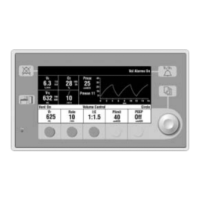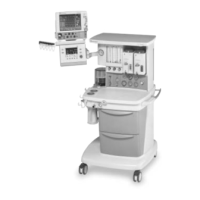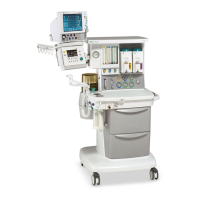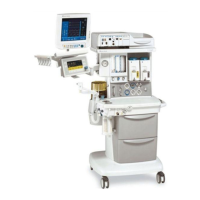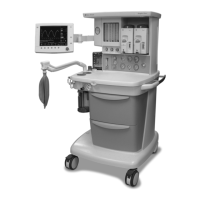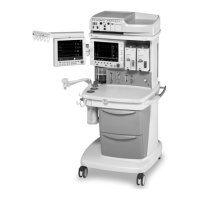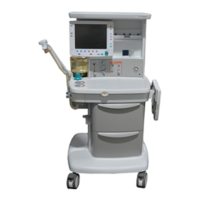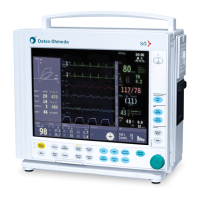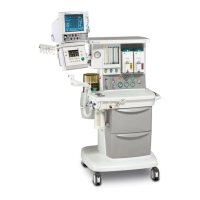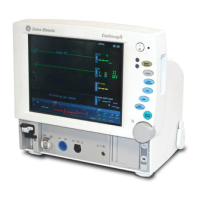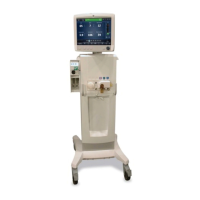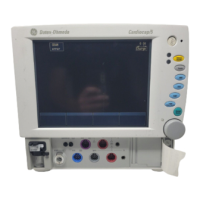Do you have a question about the Datex-Ohmeda Aestiva/5 and is the answer not in the manual?
Explains how to navigate and use the manual's sections and content.
Provides a general description of the Aestiva anesthesia delivery system and its features.
Describes the built-in ventilator and monitoring capabilities of the system.
Explains the meaning of various symbols used in the manual and on the equipment for safety and operation.
Details the primary controls for the anesthesia system, including warnings.
Explains the location and function of system circuit breakers on the rear panel.
Describes the various controls and components of the breathing system.
Outlines the controls for setting agent concentration and silencing alarms on vaporizers.
Details the controls and features of the ventilator's control panel.
Explains the function of the End Case key in preventing false alarms and resetting settings.
Provides step-by-step instructions on how to adjust system control settings.
Guides users on navigating and interacting with the system's menu interface.
Illustrates the system's menu structure and available options for navigation.
Provides detailed explanations for various functions accessible through the system menus.
Details the process for modifying settings within the system's menus.
Describes the available optional flowmeter and suction regulator systems.
Explains the operation and controls for the suction regulator.
Details the operation of external flowmeter controls for gas flow adjustment.
Explains the operation and implications of the optional CO2 Bypass mode.
Step-by-step guide on powering on and initializing the anesthesia system.
Instructions for adjusting the audible alarm volume level on the system.
Explains how to display or conceal alarm limits and measurement units on the screen.
Details how to configure patient data settings for Heliox ventilation mode.
Guides on enabling or disabling the system's volume alarms.
Instructions for setting and adjusting various alarm limits for patient safety.
How to configure the audible alarm for detecting circuit leaks.
Describes setting the Cardiac Bypass mode to manage alarms during procedures.
Step-by-step instructions for initiating mechanical ventilation on the system.
Step-by-step instructions for stopping mechanical ventilation on the system.
Explains how to select and set different ventilation modes for patient care.
Details how to adjust various parameters for ventilator operation.
Explains settings and operation for the Volume Control ventilation mode.
Explains settings and operation for the Pressure Control ventilation mode.
Explains settings and operation for the SIMV ventilation mode.
Explains settings and operation for the PSVPro ventilation mode.
How to set the inspiratory pause feature for volume control ventilation modes.
Instructions for setting additional ventilator controls for SIMV and PSVPro modes.
How to use the alarm silence key to manage audible alarms.
Guide on interpreting the pressure waveform displayed by the system.
Explains how the display automatically adjusts time and pressure scales.
Procedure for measuring the compressible volume in patient breathing circuits.
How to access and view service-related settings and information.
Description of the operation for the passive Anesthesia Gas Scavenging System.
Details on the operation of optional active Anesthesia Gas Scavenging Systems.
Instructions for connecting the active AGSS with a flow indicator.
Instructions for connecting the active AGSS without a flow indicator.
Daily checklist items to perform before the first patient of the day.
Tests to perform each time a new clinician operates the anesthesia system.
Essential checks and tests to conduct before connecting any patient.
Outlines the recommended intervals for performing preoperative tests.
Detailed inspection and test procedures for daily system readiness.
Steps to reduce the number of system alarms for easier operation.
Procedures for testing pipeline and cylinder gas supplies for leaks and pressure.
Steps for verifying the correct function of gas flow controls.
Procedure to test for back pressure issues with the vaporizers.
Verifies the system's behavior and alarms during a power failure.
Comprehensive tests for various system alarms to ensure proper function.
Preparatory steps and checks required before starting a patient case.
Tests to be performed whenever a new clinician operates the anesthesia system.
Detailed procedures for performing low-pressure leak tests on the system.
Specific protocol for conducting low-pressure leak tests according to ISO 5358 or BSI standards.
Final checks to perform before connecting a patient to the system.
Guidelines and steps for correctly installing and checking vaporizers.
Procedures for testing the functionality of the breathing system components.
Tests to verify the correct operation of patient monitors and the ventilator.
| Type | Anesthesia Machine |
|---|---|
| Brand | Datex-Ohmeda |
| Model | Aestiva/5 |
| Ventilation Modes | Volume Control, Pressure Control, SIMV, Manual |
| Breathing System | Circle system |
| Electrical Requirements | 100-240 VAC, 50/60 Hz |
| Tidal Volume Range | 20-1500 ml |
| Oxygen Concentration | 21-100% |
| Gas Supply | O2, N2O, Air |
| Vaporizer Mounts | Selectatec |
| Alarms | Apnea |
| Flowmeters | O2, N2O, Air |
| Respiratory Rate | 4 to 100 breaths per minute |
| Inspiratory Time | 0.2 to 5 seconds |
| PEEP | 0 to 20 cm H2O |
| Vaporizer | Tec series |
